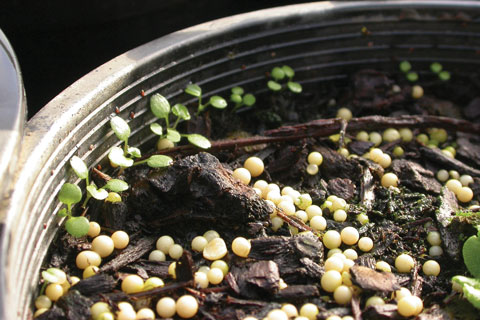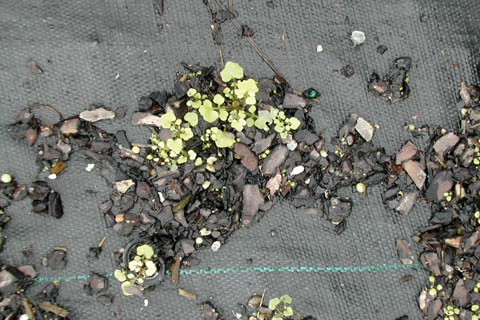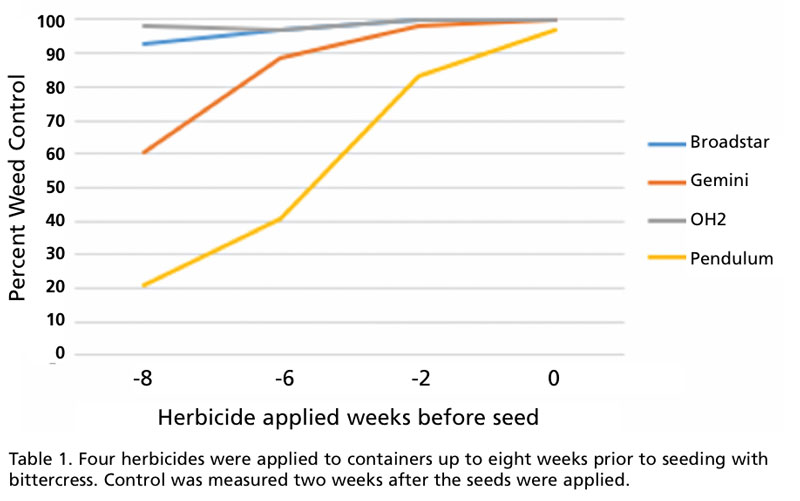2/1/2018
A War of Numbers
Silvia Valles Ramirez & James Altland
The most prevalent weed in U.S. container nurseries is bittercress (Cardamine flexuosa). It’s not the most difficult weed to kill, but its short growth cycle and ability to produce large numbers of seed make it very difficult to manage.
Bittercress wages a war of numbers that can fatigue even the most experienced nursery manager. First, we must understand the biology of this weed and why it’s so abundant, then we can develop a comprehensive control strategy to limit its growth and spread.
Nomenclature
Bittercress is known by several common names in different regions of the country, including snapweed, pepper weed, popcorn weed, shotgun weed and many others. Most of these names refer to the plant’s ability to forcefully project its seeds like tiny cannons. We’ll refer to its most commonly used name: bittercress.
The Latin name of the weed has been debated. It was once widely thought that hairy bittercress (Cardamine hirsuta) was the species most prevalent in nursery containers. Numerous books, extension publications and magazine articles refer to this particular species.
Research at North Carolina State University collected bittercress from nurseries throughout the U.S. and used morphological characteristics along with DNA techniques to accurately identify the plants and determine which species are most abundant in nursery containers. They concluded that virtually all bittercress in container crops was a species called flexuous bittercress (C. flexuosa). Contrary to popular belief, hairy bittercress is rarely found in container nurseries, although it’s commonly found in landscapes and roadsides. From here on out, all discussions will refer to flexuous bittercress.
Biology
Bittercress seedlings emerge primarily in the cool fall and spring seasons; however, germination in a nursery setting can occur throughout the year due to the artificially cool climate created by canopy shade and frequent irrigation. Seedlings have oval cotyledons with a small notch at the tip. The first true leaves are club shaped.
Shortly after germination, a small rosette forms with deeply lobed foliage. Flowering stems with more elongated leaves emerge from the rosette. Flowers occur in clusters called racemes. Individual flowers are white with four petals. Stamen within the flowers are critical for distinguishing the two major bittercress species. C. hirsuta flowers have a variable number of stamen. Most flowers have four stamen (80%), some have five (18%) and a few have six (2%). C. flexuosa always has six stamen.
A single bittercress plant produces up to 5,000 seeds. Seeds are forcefully projected from the mature silique (fruit pod) up to 3 ft. from the mother plant. Seeds have up to 99% viability and can germinate in about five days. Bittercress germinate best under shaded conditions, making hoophouses and other shade structures ideal germination sites. While moderate shade is optimum for germination, seed still germinate in either full sun or complete darkness.
Flexuous bittercress (C. flexuosa) seed have no dormancy mechanism and germinate upon dispersal year-round in container crops. In contrast, C. hirsuta seeds have innate dormancy when released from the mother plant and thus only germinate in late fall or early spring. The dormancy mechanism in C. hirsuta seed is likely the reason this species doesn’t occur in containers. A common thread among all container weed species is that their seeds lack dormancy, allowing them to reproduce multiple times in a growing season.

Sanitation
Sanitation is the most important tool for controlling bittercress. One bittercress plant can produce nearly 5,000 seeds in just five weeks. A short life cycle and the ability to project seeds several feet from the mother plant makes sanitation paramount. The two primary deficiencies we’ve observed in many nurseries, with regard to sanitation, is failure to control bittercress on the gravel beneath containers and the use of old pots.
Bittercress is a weed that can thrive with limited resources. It germinates readily in coarse gravel and on top of woven weed fabrics. With just a thin layer of bark, bittercress will reproduce and likely expel seed into nearby containers. There must be a concerted effort to kill bittercress growing in gravel and to remove debris from weed fabric that might serve as a repository for germination (Figure 1).
Figure 1. Bittercress seeds and seedlings can be seen on the edge of this dirty reused container.
Old and reused containers harbor many weed seeds. Bittercress seeds are small and remain attached to plastic containers. Many have commented that herbicides are least effective near the container edge. Shrinking and swelling of the container substrate may reduce herbicide efficacy; however, poor sanitation and use of old pots is more likely the reason why weeds seem to germinate near the container edge.
 We recently conducted a series of experiments to determine killing temperatures for using hot water to clean old nursery pots and trays. We found that water at temperatures from 185 to 203F (85 to 95C) killed 100% of bittercress seed in as little as one minute of exposure. Lower temperatures can kill seed, but require greater exposure times. (Figure 2).
We recently conducted a series of experiments to determine killing temperatures for using hot water to clean old nursery pots and trays. We found that water at temperatures from 185 to 203F (85 to 95C) killed 100% of bittercress seed in as little as one minute of exposure. Lower temperatures can kill seed, but require greater exposure times. (Figure 2).
Figure 2. Bittercress germinate and grow in very small piles of debris, even on top of weed fabric.
Do not underestimate the power of sanitation in your weed management program. A sound sanitation program is more effective, in terms of total weed control, than any pre-emergence herbicide on the market.
Chemical control
No sanitation program is perfect and that’s where pre-emergence herbicides earn their cost. Be sure that applications of pre-emergence herbicides are made prior to bittercress germination. This can be difficult considering the weed germinates year-round with no well-defined period of emergence. Use the following rules to guide application timing:
• Apply pre-emergence herbicides one to three days after potting (follow label instructions). If bittercress seeds are dispersed into recently potted containers, they’ll germinate quickly. It’s important to have the chemical barrier from the pre-emergence herbicide established quickly.
• Scout containers regularly to look for escape weeds. An increase in the number of germinating weeds is an indication that the chemical barrier has deteriorated and another pre-emergence herbicide application is needed.
• Organize a work crew to thoroughly handweed all containers and follow with an herbicide application immediately (the same or next day).
• Plan for a final pre-emergence herbicide application just prior to overwintering. Applications must normally occur three weeks prior to covering, but varies with each product (follow label instructions). The mild and constantly cool climate beneath overwintering structures is ideal for bittercress growth. Make sure an effective herbicide is applied uniformly and thoroughly prior to overwintering.
 The most effective herbicide for bittercress control will depend on a number of factors relative to how containers are managed. We’ve conducted many experiments on container weed control throughout our careers. Summarizing across these many experiments, we found that Snapshot (isoxaben+trifluralin) is consistently one of the most effective products for controlling bittercress. BroadStar (flumioxazin), RegalStar (oxyfluorfen+oxadiazon) and Rout (oxyfluorfen+oryzalin) also provide very good control.
The most effective herbicide for bittercress control will depend on a number of factors relative to how containers are managed. We’ve conducted many experiments on container weed control throughout our careers. Summarizing across these many experiments, we found that Snapshot (isoxaben+trifluralin) is consistently one of the most effective products for controlling bittercress. BroadStar (flumioxazin), RegalStar (oxyfluorfen+oxadiazon) and Rout (oxyfluorfen+oryzalin) also provide very good control.
The length of control from different pre-emergence herbicide products isn’t the same. We recently conducted an experiment with four pre-emergence herbicides to see how long the herbicide would remain effective in the container. The herbicides were applied either zero, two, six or eight weeks prior to sowing bittercress seeds in the containers. BroadStar and OH2 (oxyfluorfen+pendimethalin) provided excellent control, even when applied eight weeks prior to seed application. This suggests that these two herbicides would still be active at a high level for eight weeks after application.
Gemini (isoxaben+prodiamine) provided good (but declining) control for six weeks, but after eight weeks, control was not satisfactory.
And finally, Pendulum only provided control for a short period of time. It was previously thought that pre-emergence herbicides would persist for about 90 days in container crops. Our research has consistently shown that even the best herbicides only provide a high level of control for about 60 to 70 days (Table 1).
Summary
The most effective bittercress control starts with sanitation and uses pre-emergence herbicides as a supplemental control tool. Take the following steps to minimize the impact of bittercress in your nursery:
• Vigorously control all weeds growing on gravel and weed fabric beneath the containers. Re-evaluate your maintenance and herbicide applications procedures between crops when the gravel pads are empty. Can you improve the sanitation, removal of debris and application of herbicides? Take steps to establish a clean production area while the gravel is free of containers to minimize the occurrence of bittercress during production.
• Use new, or at least clean, propagation pots. When reusing old pots, clean or sterilize the pots using hot water dips or steam applications. It’s inexpensive and easy to kill weed seeds with hot water (or steam) and it’s perhaps the most dramatic way to reduce bittercress in propagation areas.
• Apply proven-effective pre-emergence herbicides to clean, weed-free containers.
• Scout the production area, especially in and around propagation, and take actions to remove or control bittercress plants that emerge. Be vigilant, even militant, when it comes to removing bittercress growing in production areas. GT
Silvia Valles Ramirez is a visiting scientist at the Ohio State University. Dr. James Altland is a Research Horticulturist with the USDA-ARS in Wooster, Ohio. He can be reached by email at james.altland@ars.usda.gov. Mention of any commercial product in this article is for educational purposes only and should not be considered an endorsement by the Ohio State University or USDA-ARS.